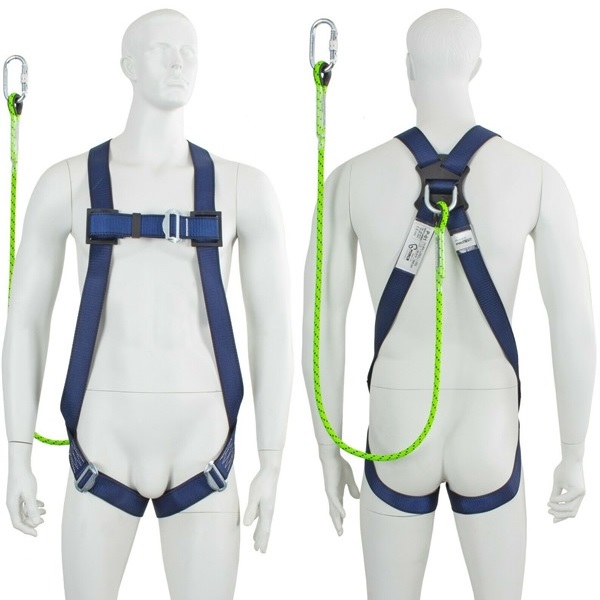
There are some important differences between the terms fall restraint and fall arrest, and it's extremely important to understand these differences (and use the correct safety equipment) when working at height.
According to current height safety regulations, you must:
- Avoid working at height where it's reasonably practicable to do so.
- Where work at height cannot be avoided, make the working area as safe as possible and take appropriate fall prevention measures (such as installing edge protection barriers).
- Use a fall restraint system to stop the worker from reaching a fall hazard (like an unprotected roof edge or an open manhole).
- Use a fall arrest system to limit the distance and consequences of a fall. This option should always be the last resort and must also include adequate means of rescue.
All fall protection systems - including fall restraints AND fall arrests - consist of three essential pieces of equipment: anchors, lanyards and harnesses.
Anchors Lanyards Harnesses
Let's take a closer look at the two different types of fall protection system...
Fall Restraint
What are fall restraints?
Fall restraints prevent the worker from being able to reach fall hazards in the first place. Fall restraint systems normally includes a fixed-length lanyard connected to a suitable anchorage point at one end and the worker's safety harness at the other. The length of the lanyard is adjusted to prevent the worker from being able to reach a fall hazard. Fall restraint systems are also referred to as work restraint or simply restraint systems.
When to use fall restraint equipment
A fall restraint system should always be considered before a fall arrest system (in accordance with the current working at height regulations) since fall restraints prevent falls from happening at all. A fall restraint system might also be considered where limited ground clearance is available below the work area. Restraint equipment typically requires less intervention from the worker as they're able to work continuously at a fixed distance from the anchorage point.
Fall restraints are also typically more cost-effective than fall arrest systems due to the fact that shock absorbers are not necessary, and you're not required to have a rescue plan in place for the duration of the work as there should be zero chance of the worker falling or being suspended in their harness.
Fall Arrest
What does 'fall arrest' mean?
A fall arrest system provides maximum freedom of movement for the worker - however, in doing so, it also enables the worker to reach a position where an accidental fall could occur. In the event of a fall, the fall arrest system ensures the worker will be caught before descending. Fall arrest equipment must be selected and positioned to limit the distance and consequences of the fall.
When using a fall arrest system, you will need to utilise a fall arrest harness and an appropriate lanyard. Fall arrest harnesses decelerate the momentum of a fall by absorbing the kinetic energy. Fall arrest harnesses are ergonomically designed to provide utmost comfort, both while working at height and in the event of a fall.
When using fall arrest systems, it's essential that you always use the correct equipment. Click the links below to browse the wide range of fall arrest anchors and fall arrest blocks available from SafetyLiftinGear.
Fall Arrest Anchors Fall Arrest Blocks
IMPORTANT: When choosing a fall arrest harness, you must ensure that it is fit for purpose. A fall protection harness that's designed to restrain the worker may not be able to safely halt a worker who has fallen from height. Choose a harness that's specifically designed to be used as part of a fall arrest system.
When to use a fall arrest system
A fall arrest system should be used where it is not possible to restrict the worker from reaching a fall hazard. Fall arrest systems would typically be used when work needs to be completed on fragile surfaces, or when the worker is required to work over the leading edge of a fall hazard. If a worker is able to reach a fall hazard, fall arrest equipment (e.g. a fall arrest harness) must be used. Following a fall, consideration must be given to the rescue of the worker - leaving the worker suspended in the air for an extended period of time can result in suspension trauma.
Rescue Equipment
The law states that, when planning work at height, consideration must be given to a full and comprehensive rescue plan. The rescue plan is intended to reduce the risks associated with the worker being suspended after a fall has occurred, and must ensure that the rescue is completed in a prompt and safe manner.
There are several methods of rescue available that are specific to the work environment and location of a fall. Here at SafetyLiftinGear, we offer variety of emergency rescue systems to allow the fast and efficient rescue of a suspended worker.
Click the button below to explore our full range of fall arrest and fall restraint equipment...
Fall Protection Equipment
...and if you have any questions about our fall protection systems, don't hesitate to contact SafetyLiftinGear today.

